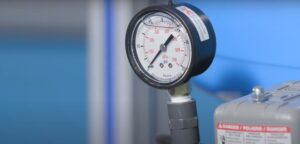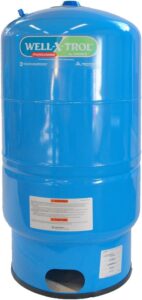In this article, we will discuss the common water pressure tank problems and how you can troubleshoot them. This article will also focus on how to fix a waterlogged well water pressure tank?
Similar Topic: Well Water Pressure Tank | Everything you need to know
Water Pressure Tank Problems
Loud Noises: A loud bang in your plumbing system happens when when the water flow suddenly stops in the pipes or pressure tank fails to maintain constant water pressure. The water pressure inside the tank can get disturbed due to air pressure drop or increase, wrong pressure settings on the pump, or diaphragm damage.
Worn Out Well Pumps: The water tank sends a signal to the well pump to turn on/off. A faulty water tank will send wrong signals, forcing the pump to operate incorrectly.
You can fix this by checking the air pressure in the pressure tank. The air pressure must be 2-3 PSI less than the cut-on pressure of your well pump. If the cut-on pressure on your well pump is 30 PSI, the air pressure in the pressure tank must be 27-28 PSI.
High Electricity Bills: If you notice a sudden increase in your electricity bill, without installing any new appliances in your home, don’t forget to check the water pressure tank and pump.
Read More: Is Well Water Safe to Drink after a Power Outage?
Low Water Pressure or No Water: If the pump is running and you notice no water or low pressure in the faucets, it is likely due to a faulty water tank. Low water pressure can indicate a failing pump, closed valve, leaking pipe, or leaking pressure tank.
Change in Water Quality: The sediment in well water gets deposited over time at the bottom of the tank. They can be pumped in the plumbing system when water demand is high.
Clean the tank to fix the sediment problem if you have checked water filter and water softeners.
How to Fix a Waterlogged Well Water Pressure Tank
The pressure tank maintains a constant ratio of air to water in it. If there is more water in the tank than air, it is said to be waterlogged.
Sings of a Waterlogged Tank
- The water pump turns on/off continuously.
- Water coughing or pulsating at taps.
- A high percentage of coliform bacteria in water samples.
- Odors in water.
How to fix a Waterlogged Bladder Tank?
Usually you can’t fix a waterlogged bladder or a diaphragm tank but some homeowners have delayed the replacement with the help of following steps.
- Turn off the power to your well pump.
- Bypass the water filter/softener.
- Open the drain valve on the tank and drain the water in the tank.
- Connect a pressure gauge to the pressure valve at the top of the tank and note down the pressure. If the pressure gauge shows 27-28 PSI, the pressure system in the tank is all right.

- Adjust air pressure using an air compressor to reach the desired pressure.
- Power the well pump and check the tank to see if the problem has been fixed.
How to fix a Waterlogged Air over Water Tank?

Here is how you can fix it.
- Turn off the power to the well pump and empty the pressure tank.
- Connect a pressure gauge at the air valve at the top and see the reading. It must be 2-3 PSI less than the pressure settings.
- Adjust the air using an air compressor.
- Turn on the power and test the system.
- Replace the tank if needed.
